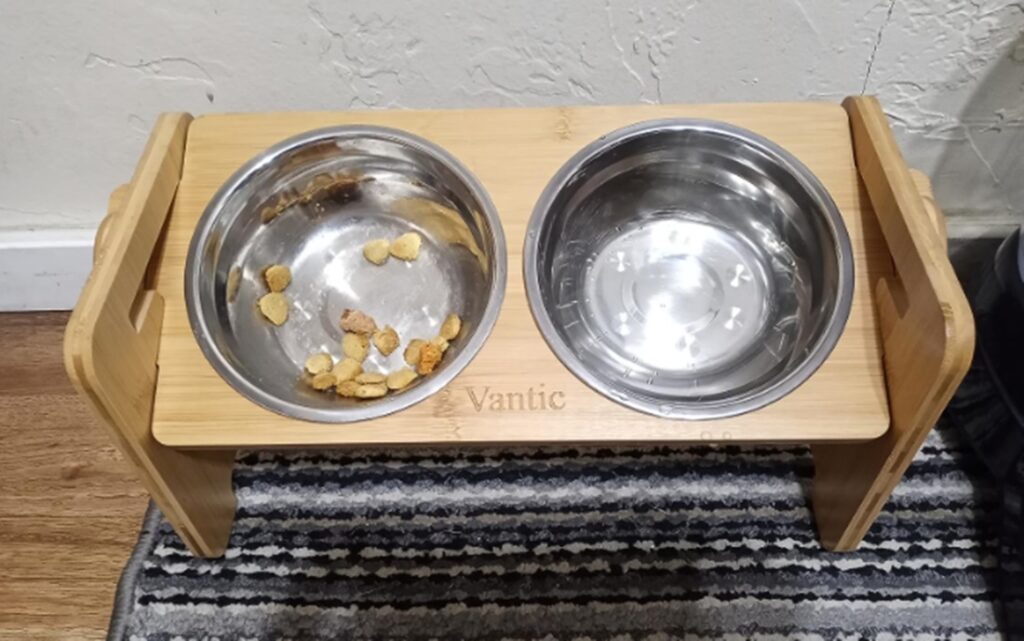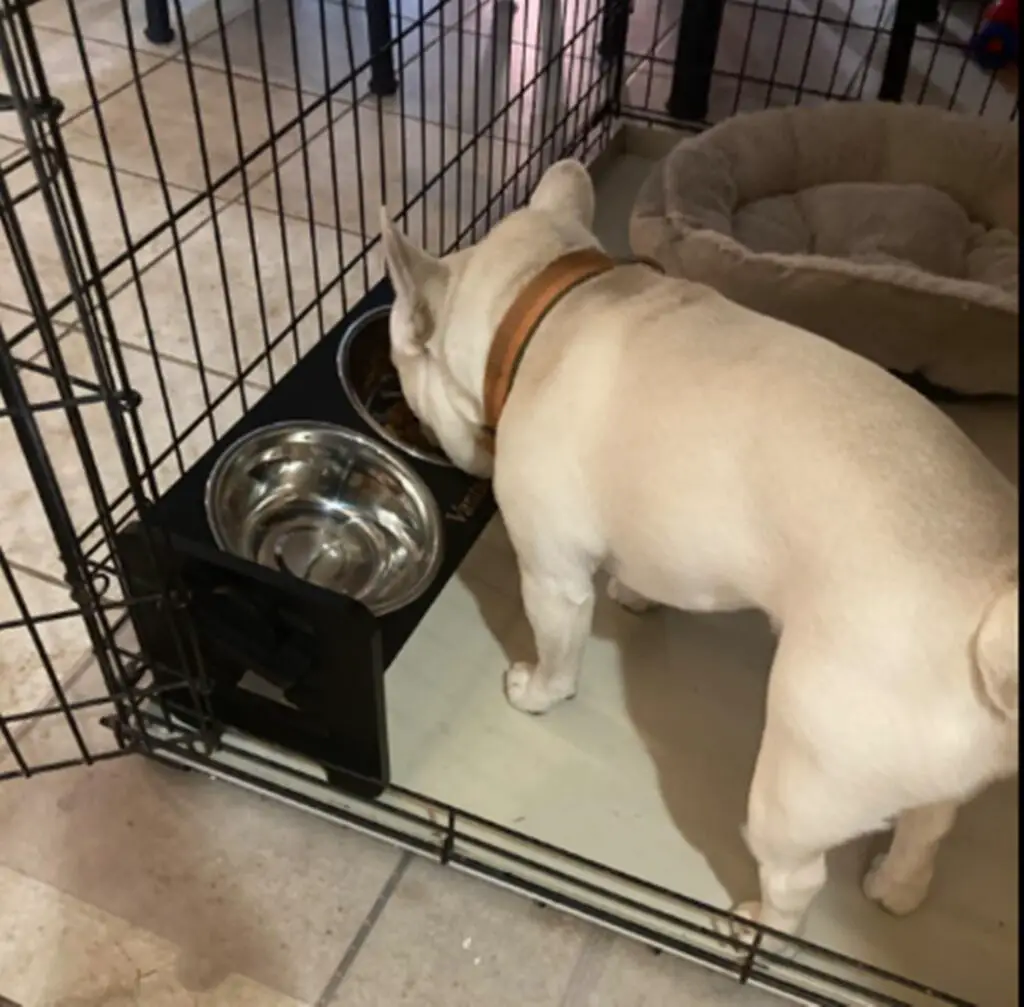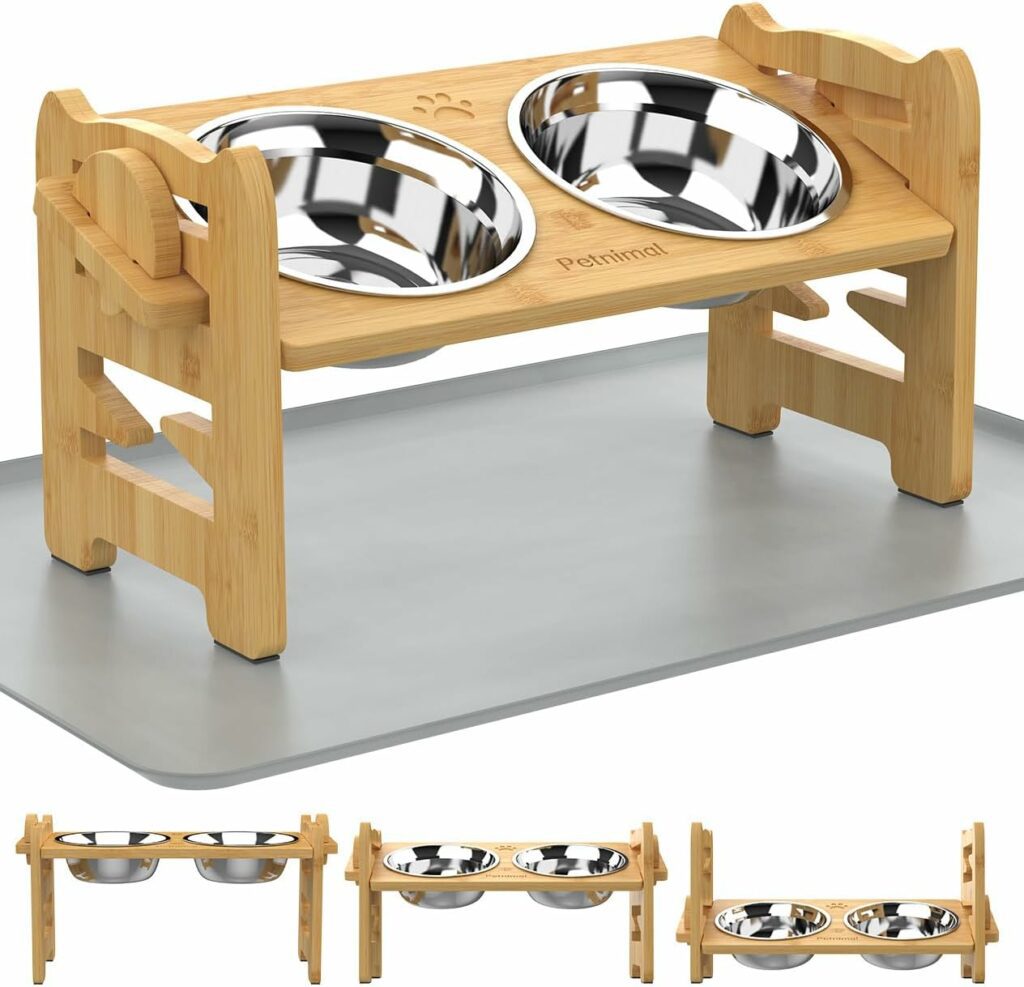Are tilted bowls better for dogs? This has become a popular question among pet owners who want to make sure their furry friends are eating comfortably.
There are some key factors that can help you decide whether or not to use a tilted bowl for your pup.
In this blog post, we’ll discuss these factors and explore the pros and cons of using tilted bowls for dogs.
- Key Takeaway
- What Is An Elevated Tilted Dog Bowl?
- Are Tilted Bowls Better For Dogs?
- How High Should a Raised Dog Feeder Be?
- The Benefits of Elevated Tilted Dog Bowls
- Potential Drawbacks From Using Elevated Dog Bowls
- What Breeds Can Benefit From an Elevated Dog Feeder?
- Debunking Myths and Facts of Elevated Food Bowls for Dogs
- Do Vets Recommend Elevated Dog Bowls?
- Choosing the Right Dog Food Bowl (Yes, It Matters!)
- FAQs
- Q: Why should I use an elevated dog bowl?
- Q: Are elevated dog bowls better for larger dogs?
- Q: Can elevated dog bowls help prevent bloat?
- Q: Can elevated dog bowls be used for both food and water?
- Q: What are the benefits of using elevated food bowls?
- Q: Can elevated dog bowls be used for slow feeding?
- Q: Are elevated dog bowls easy to clean?
- Conclusion and final thoughts
Key Takeaway
- An elevated dog bowl is a pet feeding dish that is raised off the ground and typically placed in a stand, designed to allow dogs to eat or drink at a height that’s more comfortable and natural for their size and breed.
- Tilted bowls can be better for dogs, particularly for flat-faced breeds, as they promote cleaner mealtimes and easier breathing, and elevated bowls can also improve posture and comfort during eating, especially for dogs with joint issues.
What Is An Elevated Tilted Dog Bowl?

An elevated dog bowl is a type of feeding dish that is raised off the ground, typically by a stand or a platform, to bring it closer to a dog’s mouth level.
Elevated dog bowls, also known as raised dog bowls, are designed with the primary purpose of making eating and drinking more comfortable for dogs.
They can be particularly beneficial for larger breeds, older dogs, or dogs with certain health conditions.
Are Tilted Bowls Better For Dogs?

Yes. Tilted bowls can be beneficial for dogs, particularly for flat-faced breeds, as they can promote cleaner mealtimes and easier breathing.
Tilted dog bowls, also known as angled or elevated bowls, are designed at a slant to make it easier for dogs to access their food or water.
This design is particularly beneficial for brachycephalic or flat-faced breeds such as Bulldogs, Pugs, and Boston Terriers, which can struggle with typical flat bowls due to their unique facial structure.
Cleaner mealtimes are one of the key benefits of tilted bowls. The angled design helps keep food-centered, reducing the amount of food that gets pushed out to the edges and making it easier for dogs to eat. This can result in less mess around the feeding area.
Additionally, the angle of the bowl can facilitate easier breathing during mealtime. Flat-faced breeds often have difficulty eating from flat bowls without blocking their airways, but the tilt of these bowls allows them to eat while maintaining better airflow.
How High Should a Raised Dog Feeder Be?
| Breed | Average Height (at shoulder) | Recommended Feeder Height |
|---|---|---|
| Labrador Retriever | 22-24 inches | 22-24 inches |
| German Shepherd | 22-26 inches | 22-26 inches |
| Golden Retriever | 21-24 inches | 21-24 inches |
| French Bulldog | 11-12 inches | 11-12 inches |
| Beagle | 13-15 inches | 13-15 inches |
| Poodle (Standard) | 18-24 inches | 18-24 inches |
| Yorkshire Terrier | 8-9 inches | 8-9 inches |
The Benefits of Elevated Tilted Dog Bowls
Elevated dog bowls offer several benefits including reducing mess, alleviating physical discomfort, and promoting healthier eating habits.
No more splash zone
Elevated dog bowls can help contain the mess that dogs often make while eating or drinking. By raising the bowls off the floor, spills and splashes are less likely to reach the surrounding area, keeping your floors cleaner. It also prevents food debris from scattering around, making the feeding area more hygienic.
Reduces orthopedic pain
For dogs with joint or bone issues like arthritis or hip dysplasia, bending down to eat or drink can cause discomfort or pain. Elevated bowls bring the food and water closer to the dog’s mouth, reducing the need for them to bend their neck and put pressure on their joints. This can help alleviate orthopedic pain in these dogs.
Reduces neck strain
Similarly, elevated bowls can reduce neck strain in all dogs, not just those with orthopedic issues. Constantly bending down to eat or drink can put a strain on a dog’s neck over time. By raising the bowls to the dog’s chest level, they can maintain a more comfortable, natural posture while eating.
Megaesophagus-friendly
Dogs with megaesophagus, a condition where the esophagus is enlarged and makes it difficult for them to swallow, can benefit greatly from elevated bowls. Eating from an elevated position can help gravity move the food down the esophagus, making swallowing easier and reducing the risk of choking or regurgitation.
Keeps bowls in place
Elevated dog bowls often come with stands or holders that keep the bowls securely in place, preventing them from moving around as your dog eats or drinks. This not only reduces mess but also makes mealtime less frustrating for dogs that may struggle with bowls that slide around on the floor.
Overall Best Tilted Dog Bowl

Petnimal Elevated Dog Bowls
This tilted dog bowl is winning the hearts of dogs.
Potential Drawbacks From Using Elevated Dog Bowls
While elevated dog bowls have their benefits, they also come with potential drawbacks such as increased risk of bloat for certain breeds, cost, and incorrect sizing issues.
Increased Risk of Bloat for Certain Breeds
Elevated dog bowls may increase the risk of Gastric Dilatation-Volvulus (GDV), also known as bloat, in certain breeds.
Bloat is a life-threatening condition that occurs when a dog’s stomach fills with gas and possibly twists. Large, deep-chested breeds like Great Danes, Weimaraners, and Saint Bernards are particularly at risk.
Cost
Elevated dog bowls can be more expensive than traditional floor bowls. Depending on the design, material, and brand, some elevated feeders can be quite pricey. This may not be an issue for everyone, but for those on a tight budget, it could be a significant drawback.
Incorrect Sizing Issues
Finding the correct size of the elevated feeder can be challenging. If the feeder is too high, it can cause your dog to lift their head excessively while eating, which could potentially lead to issues like choking. If it’s too low, it defeats the purpose of having an elevated bowl in the first place.
Spills and Tipping Over
While elevated bowls can reduce splashes, if a dog is particularly enthusiastic or clumsy, it might still manage to knock over the entire stand, leading to a bigger mess.
Not Suitable for Puppies
Puppies, particularly of larger breeds, should not use elevated bowls as they can contribute to uneven growth rates, which can lead to developmental orthopedic diseases.
What Breeds Can Benefit From an Elevated Dog Feeder?
| Breed | Reason |
|---|---|
| Great Dane | Large size, prone to bloat and hip dysplasia |
| Saint Bernard | Large size, prone to bloat |
| Weimaraner | Deep chested, prone to bloat |
| German Shepherd | Prone to hip dysplasia and arthritis |
| Labrador Retriever | Prone to orthopedic issues |
| Golden Retriever | Prone to orthopedic issues |
| Basset Hound | Long body and short legs, prone to spinal issues |
Debunking Myths and Facts of Elevated Food Bowls for Dogs
While elevated food bowls for dogs are popular, there are various myths and facts associated with their use, ranging from health benefits to behavioral changes.
Elevated Dog Food Bowls Reduce Bloat in Large Breeds
This statement is largely a myth. While it was once believed that elevated bowls could help reduce the risk of bloat, especially in large and deep-chested breeds, more recent studies suggest that they may actually increase the risk.
Bloat is a serious condition where the dog’s stomach fills with gas and possibly twists. However, each dog is unique and has different needs, so it’s always best to consult with a veterinarian.
Elevated Dog Food Bowls Create a Healthier Posture for Dogs
This is a fact. Elevated dog food bowls can promote a healthier posture in dogs by allowing them to eat at a level that’s more natural for their size and breed.
This can be particularly beneficial for dogs with arthritis or other joint issues, as it reduces the need for them to bend down when eating or drinking.
Elevated Dog Food Bowls Promote Cleaner Eating
This is both a fact and a myth. On one hand, elevated bowls can indeed keep the feeding area cleaner by containing spills and preventing food debris from scattering.
However, if a dog is particularly enthusiastic or clumsy, they might still manage to knock over the entire stand, leading to a bigger mess.
Elevated Dog Food Bowls Don’t Slide Across the Floor
This is generally a fact. Most elevated dog bowls come with stands or holders that keep the bowls securely in place, preventing them from sliding across the floor as your dog eats. This makes meal times less frustrating for dogs and keeps the feeding area cleaner.
Elevated Bowls Solve One Specific Problematic Behavior in Dogs
This statement is a myth. While elevated bowls can certainly help with certain issues, such as reducing strain on the neck or joints, they are not a cure-all solution for all behavioral problems.
For example, they won’t stop a dog from eating too fast, which can lead to other health issues like choking or even bloat. If your dog has problematic behaviors around mealtime, it’s best to consult with a veterinarian or a pet behaviorist.
Do Vets Recommend Elevated Dog Bowls?
Veterinarians’ recommendations on elevated dog bowls vary, with some suggesting they can be beneficial for dogs with specific health conditions, while others caution against their use due to potential risks.
The stance on elevated dog bowls among vets is not uniform. Some vets recommend them, particularly for dogs with specific health conditions such as arthritis, hip dysplasia, or megaesophagus, where the elevated position can aid digestion and reduce strain on joints.
In these cases, an elevated feeder can provide relief from discomfort and make meal times more enjoyable for the pet.
However, other vets advise against the use of elevated bowls, especially for large and deep-chested breeds.
This is due to research suggesting that elevated feeders might increase the risk of Gastric Dilatation-Volvulus (GDV), commonly known as bloat, a serious and potentially life-threatening condition.
Choosing the Right Dog Food Bowl (Yes, It Matters!)
Choosing the right dog food bowl is important as it can impact your pet’s health, comfort, and eating habits. Several factors need to be considered such as the material, size, depth, and elevation of the bowl.
Material
The material of the dog bowl matters because it directly interacts with the dog’s food and water. Stainless steel bowls are often recommended as they are durable, easy to clean, and resistant to scratches and cracks where bacteria could hide.
Ceramic bowls can also be a good option, but they are prone to breakage. Plastic bowls, although cheap and lightweight, can harbor bacteria in scratches over time and some dogs may have an allergic reaction to certain types of plastic.
Size
The size of the dog bowl should match the size of your dog. A bowl that is too small may not hold enough food or water for larger breeds, while a bowl that is too big may overwhelm smaller dogs or puppies.
Ideally, when your dog is standing normally, the rim of the bowl should reach the level of the dog’s chest.
Depth
The depth of the bowl is another factor to consider. Deep bowls are suitable for dogs with long noses, like Greyhounds and Collies, as they allow comfortable access to food.
On the other hand, shallow bowls are better for breeds with flatter faces like Bulldogs and Pugs.
Elevation
Whether or not to use an elevated bowl depends on your dog’s breed, size, and health conditions. As discussed earlier, elevated bowls can help dogs with specific health issues such as arthritis by reducing strain on their joints.
However, they may increase the risk of bloat in certain large and deep-chested breeds. Always consult with your vet before deciding on an elevated feeder.
Stability
Look for a dog bowl with a non-slip base. This prevents the bowl from sliding around as your dog eats, which can be frustrating for the dog and messy for you.
FAQs
Q: Why should I use an elevated dog bowl?
A: Using an elevated dog bowl can have several advantages. It can help prevent bloat in large breeds, reduce strain on the dog’s neck and joints, and make it easier for the dog to eat and drink comfortably.
Q: Are elevated dog bowls better for larger dogs?
A: Yes, elevated dog bowls are often recommended for larger dogs. The raised height can help improve their posture while eating and drinking, reducing strain on their neck and joints.
Q: Can elevated dog bowls help prevent bloat?
A: Yes, elevated dog bowls can help reduce the risk of bloat in large breeds. By keeping the dog’s head at a higher level, it can prevent them from swallowing air while eating, which is one of the causes of bloat.
Q: Can elevated dog bowls be used for both food and water?
A: Yes, elevated dog bowls can be used for both food and water. There are models available that have separate compartments for food and water, while others have one large bowl for both.
Q: What are the benefits of using elevated food bowls?
A: Using elevated food bowls can improve the dog’s posture, reduce strain on their neck and joints, prevent bloat, and make it easier for them to eat comfortably, especially for dogs with arthritis or other joint issues.
Q: Can elevated dog bowls be used for slow feeding?
A: Yes, elevated dog bowls can be used for slow feeding. There are specialized slow feeder bowls that can be placed in the elevated stand, allowing the dog to eat at a slower pace.
Q: Are elevated dog bowls easy to clean?
A: Yes, most elevated dog bowls are easy to clean. They are often made of materials like stainless steel, which can be easily wiped clean or placed in the dishwasher for thorough cleaning.
Conclusion and final thoughts
Tilted bowls can be very beneficial for dogs. They help to reduce the amount of strain on their necks and backs while eating, which in turn helps prevent digestive issues.
Furthermore, they also provide a more comfortable eating experience for our furry friends.
While keeping tilted bowls clean may be a bit more challenging than regular bowls, the effort is worth it when you consider the improved health of our canine companions.





Leave a Reply